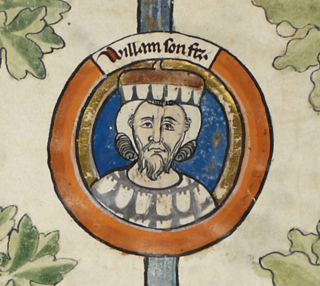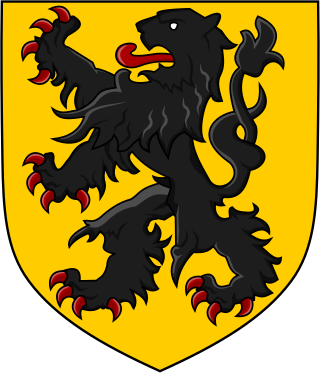Related Research Articles
Eustace I, Count of Boulogne, was a nobleman and founder of the Boulogne branch of the House of Flanders. He held the county of Boulogne from 1024 until his death in 1047.
Baldwin II was the second margrave of Flanders, ruling from 879 to 918. He was nicknamed the Bald (Calvus) after his maternal grandfather, Emperor Charles the Bald.

Arnulf I, called "the Great", was the first Count of Flanders.
Arnulf II was Count of Flanders from 965 until his death.
Baldwin IV, called the Bearded, was the count of Flanders from 987 until his death.
Baldwin VI, also known as Baldwin the Good, was Count of Hainaut from 1051 to 1070 and Count of Flanders from 1067 to 1070.

Robert I, known as Robert the Frisian, was count of Flanders from 1071 until his death in 1093. He was a son of Baldwin V, Count of Flanders, and the younger brother of Baldwin VI, Count of Flanders. He usurped the countship after defeating his nephew Arnulf III and his allies, which included King Philip I of France, Count Eustace of Boulogne and the counts of Saint-Pol and Ardres at the Battle of Cassel. He subsequently made peace with Philip, who became his stepson-in-law, but remained hostile to his sister Matilda and her husband William the Conqueror, who was king of England and duke of Normandy.

The County of Boulogne was a county within the Kingdom of France during the 9th to 15th centuries, centred on the city of Boulogne-sur-Mer. It was ruled by the counts of Flanders in the 10th century, but a separate House of Boulogne emerged during the 11th century. It was annexed by Philip II of France in 1212, after which it was treated as part of the county of Artois until it was finally annexed into the royal domain in 1550.
Arnulf III was Count of Flanders from 1070 until his death at the Battle of Cassel in 1071.
Ælfthryth of Wessex, also known as Elftrudis , was an English princess and a countess consort of Flanders to Baldwin II.

William Longsword was the second ruler of Normandy, from 927 until his assassination in 942.
Richilde, Countess of Mons and Hainaut, was a ruling countess of Hainaut from c. 1050 until 1076, in co-regency with her husband Baldwin VI of Flanders and then her son Baldwin II of Hainaut. She was also countess of Flanders by marriage to Baldwin VI between from 1067 to 1070. She ruled Flanders as regent during the minority of her son Arnulf III in 1070–1071.

Rozala of Italy was countess consort of Flanders by marriage to Arnulf II of Flanders, and queen of the Franks by marriage to Robert II of France. She was regent of Flanders in 987–988 during the minority of her son Baldwin IV of Flanders.
Edwin was the younger son of King Edward the Elder and Ælfflæd, his second wife. He drowned at sea in circumstances which are unclear. Edward the Elder died in 924, leaving five sons by three marriages. Of these, Edmund and Eadred were infants and thus excluded from the succession. Edward's careful work of expansion was undone when the Mercians chose Edward's oldest son Æthelstan – probably raised in Mercia at the court of Æthelflæd – to be their king while the West Saxons picked Ælfweard, elder son of Edward's second wife Ælfflæd, who was perhaps Edward's own choice as successor. Ælfweard's "sudden and convenient" death followed 16 days after that of his father, but Æthelstan appears not to have been recognised as king by the West Saxons until a year after his father's death, suggesting that there was considerable resistance to him and perhaps also support for Edwin.

The Abbey of Saint Bertin was a Benedictine monastic abbey in Saint-Omer, France. The buildings are now in ruins, which are open to the public. It was initially dedicated to Saint Peter but was rededicated to its second abbot, Saint Bertin. The abbey is known for its Latin cartulary whose first part is attributed to Folcwin.

Baldwin II of Boulogne was a son of Arnulf III, Count of Boulogne, whom he succeeded as count of Boulogne.

The House of Flanders, also called the Baldwins, was a medieval ruling family of Frankish origin that was founded by Baldwin Iron Arm, son-in-law of Charles the Bald. The House of Flanders was the first dynasty to transform a county function of the Carolingian Empire into a hereditary fiefdom, the County of Flanders, falling under West Francia, created by the Treaty of Verdun in 843.

Gerbod the Fleming, of Oosterzele, 1st Earl of Chester, was a hereditary advocate of the Abbey of Saint Bertin at Saint-Omer, County of Flanders and Earl of Chester in 1070.

Count of Boulogne was a historical title in the Kingdom of France. The city of Boulogne-sur-Mer became the centre of the county of Boulogne during the ninth century. Little is known of the early counts, but the first holder of the title is recorded in the 11th century.

Baldwin III, Count of Guînes (1198–1244) was a Flemish nobleman. He inherited the war-torn County of Guînes, now in northern France, while Philip II of France was still on the throne and suffered the repercussions of Philip's expansion of the French state. He is now best known as a mercenary leader in the Welsh Marches, employed by Henry III of England in 1233–1234; the family connections with properties held in England was longstanding.
References
- 1 2 Nicholas, David (1992). Medieval Flanders (1st ed.). Routledge. pp. 39–43. ISBN 9780582016781.
- 1 2 Detlev Schwennicke, Europäische Stammtafeln: Stammtafeln zur Geschichte der Europäischen Staaten , Neue Folge, Band II (Marburg, Germany: J. A. Stargardt, 1984), Tafel 5
- ↑ Nicholas, David (1992). Medieval Flanders (1st ed.). Routledge. p. 20. ISBN 9780582016781.
- 1 2 Nicholas, David (1992). Medieval Flanders (1st ed.). Routledge. p. 440. ISBN 9780582016781.
- ↑ Philip Grierson, "The Relations between England and Flanders before the Norman Conquest", Transactions of the Royal Historical Society, Fourth Series 23 (1941), p. 86
- 1 2 Renée Nip, 'The Political Relations between England and Flanders (1066-1128)', Anglo-Norman Studies 21: Proceedings of the Battle Conference 1998, ed. Christopher Harper-Bill (The Boydell Press, Woodbridge, UK, 1999), p. 150
- ↑ Régine Le Jan, 'Famille et Pouvoir dans le Monde Franc (VIIe–Xe Siècle)', Essai d'anthropologie sociale (Paris: Publications de la Sorbonne, 2003), ISBN 2-85944-268-5
- ↑ Vanderputten, Steven (April 2012). "Crises of Cenobitism: Abbatial Leadership ana Monastic Competition in Late Eleventh-Century Flanders". The English Historical Review . 127 (525): 260. JSTOR 41473996 – via JSTOR.
- ↑ Anglo-Saxon England, Volume 15, Ed. Peter Clemoes, Simon Keynes, Michael Lapidge, (Cambridge University Press, 1986), p. 93
- ↑ Foot, Sarah (2011). Æthelstan: the first king of England. Yale University Press. p. 192. ISBN 978-0-300-12535-1.
- ↑ The Annals of Flodoard of Reims, 919–966, Ed. & Trans. Steven Fanning, Bernard S. Bachrach (University of Toronto Press, 2011), p. 16
- ↑ Foot, Æthelstan, p. 42
- ↑ Lambert of Ardres, The History of the Counts of Guines and the Lords of Ardres, trans. Leah Shopkow (Philadelphia: University of Pennsylvania Press, 2007), p. 26